On this page
Books about bird physiologyThe books are listed by publication date with the most recent at the top of the page.
|
|
|
|
Diving Physiology of Marine Mammals and SeabirdsPaul J. Ponganis
Cambridge University Press
2015
"Analysing the physiological adaptations of marine mammals and seabirds, this book provides a comprehensive overview of what allows these species to overcome the challenges of diving to depth on a single breath of air. Through comparative reviews of texts on diving physiology and behaviour from the last seventy-five years, Ponganis combines this research into one succinct volume. Investigating the diving performance of marine mammals and seabirds, this book illustrates how physiological processes to extreme hypoxia and pressure are relevant to the advancement of our understanding of basic cellular processes and human pathologies. This book underscores the biomedical and ecological relevance of the anatomical, physiological and molecular/biophysical adaptations of these animals to enable further research in this area. An important resource for students and researchers, this text not only provides an essential overview of recent research in the field, but will stimulate further research into the behaviour and physiology of diving."
|
Buy from amazon.co.uk 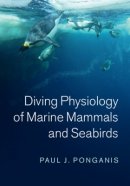
|
|
Sturkie's Avian PhysiologyEditor: Colin G. Scanes
Academic Press
2014
"Sturkie's Avian Physiology is the classic comprehensive single volume on the physiology of domestic as well as wild birds. The Sixth Edition is thoroughly revised and updated, and features several new chapters with entirely new content on such topics as migration, genomics and epigenetics. Chapters throughout have been greatly expanded due to the many recent advances in the field. The text also covers the physiology of flight, reproduction in both male and female birds, and the immunophysiology of birds. The Sixth Edition, like the earlier editions, is a must for anyone interested in comparative physiology, poultry science, veterinary medicine, and related fields. Sturkie's Avian Physiology establishes the standard for those who need the latest and best information on the physiology of birds."
|
Buy from amazon.co.uk 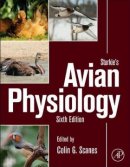
|
|
Avian Urban Ecology: Behavioural and Physiological AdaptationsEditor: Diego Gil and Henrik Brumm
Oxford University Press
2013
"As natural habitat continues to be lost and the world steadily becomes more urbanized, biologists are increasingly studying the effect this has on wildlife. Birds are particularly good model systems since their life history, behaviour, and physiology are especially influenced by directly measurable environmental factors such as light and sound pollution. It is therefore relatively easy to compare urban individuals and populations with their rural counterparts. This accessible text focuses on the behavioural and physiological mechanisms which facilitate adaptation and on the evolutionary process that ensues. It discusses topics such as acoustics, reproductive cues, disease, and artificial feeding, and includes a series of case studies illustrating cutting edge research on these areas. Avian Urban Ecology is suitable for professional avian biologists and ornithologists as well as graduate students of avian ecology, evolution, and conservation. It will also be of relevance and use to a more general audience of urban ecologists and conservation biologists."
|
Buy from amazon.co.uk 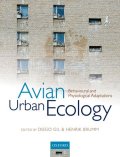
|
|
The Avian Migrant: The Biology of Bird MigrationJohn H. Rappole
Columbia University Press
2013
"The purpose of migration, regardless of the distance involved, is to exploit two or more environments suitable for survival or reproduction over time, usually on a seasonal basis. Yet individual organisms can practice the phenomenon differently, and birds deploy unique patterns of movement over particular segments of time. Incorporating the latest research on bird migration, this concise, critical assessment offers contemporary readers a firm grasp of what defines an avian migrant, how the organism came to be, what is known about its behavior, and how we can resolve its enduring mysteries. John H. Rappole's sophisticated survey of field data clarifies key ecological, biological, physiological, navigational, and evolutionary concerns. He begins with the very first migrants, who traded a home environment of greater stability for one of greater seasonality, and uses the structure of the annual cycle to examine the difference between migratory birds and their resident counterparts. He ultimately connects these differences to evolutionary milestones that have shaped a migrant lifestyle through natural selection. Rather than catalogue and describe various aspects of bird migration, Rappole considers how the avian migrant fits within a larger ecological frame, enabling a richer understanding of the phenomenon and its critical role in sustaining a hospitable and productive environment. Rappole concludes with a focus on population biology and conservation across time periods, considering the link between bird migration and the spread of disease among birds and humans, and the effects of global warming on migrant breeding ranges, reaction norms, and macroecology."
|
Buy from amazon.co.uk 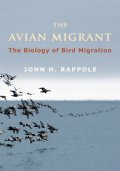
|
|
Physiological Adaptations for Breeding in BirdsTony D. Williams
Princeton University Press
2012
"Physiological Adaptations for Breeding in Birds is the most current and comprehensive account of research on avian reproduction. It develops two unique themes: the consideration of female avian reproductive physiology and ecology, and an emphasis on individual variation in life-history traits. Tony Williams investigates the physiological, metabolic, energetic, and hormonal mechanisms that underpin individual variation in the key female-specific reproductive traits and the trade-offs between these traits that determine variation in fitness."
|
Buy from amazon.co.uk 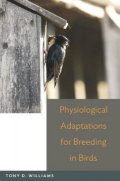
|
|
Animal PhysiologyRichard W. Hill, Gordon A. Wyse, Margaret Anderson
Sinauer Associates
3rd edition
2012
"Animal Physiology presents all the branches of modern animal physiology with a strong emphasis on integration of physiological knowledge, ecology, and evolutionary biology. Integration extends from molecules to organ systems and from one physiological discipline to another. The book takes an entirely fresh approach to each topic. Its full-colour illustrations include many novel, visually effective features to help students learn. Each of the 25 main chapters starts with a brief animal example to engage student interest and demonstrate the value of the material that will be learned. The book includes five additional, briefer 'At Work' chapters that apply students' newfound physiological knowledge to curiosity-provoking and important topics, including diving by marine mammals, the mechanisms of navigation, and muscle plasticity in use and disuse. The book is committed to a comparative approach throughout. Whereas mammalian physiology is consistently treated in depth, emphasis is also given to the other vertebrate groups, arthropods, molluscs, and - as appropriate - additional invertebrates. Concepts and integrative themes are emphasized while giving students the specifics they need.
|
Buy from amazon.co.uk 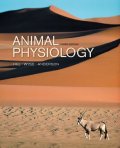
|
|
Stray Feathers: Reflections on the Structure, Behaviour and Evolution of BirdsPenny Olsen and Leo Joseph
CSIRO
2011
"Stray Feathers showcases some of the remarkable adaptations of Australian birds. A brief introduction describes how evolution shapes form and function, followed by a series of vignettes illustrating the wondrous variety of forms and functions shaped by evolution. For example, did you know that Barn Owls can hunt in absolute darkness and that cuckoos commence incubation before their egg is laid? Sections include anatomy and physiology; the senses; giving voice; tongues talking; plumage; getting around; finding and handling food; optimising foraging and feeding; reducing competition; using ‘tools'; communicating; quality vs quantity; courtship; nests; parental care; chicks; and living together."
|
Buy from amazon.co.uk 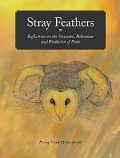
|
|
Ecological and Environmental Physiology of Birds J. Eduardo P. W. Bicudo, William A. Buttemer, Mark A. Chappell, James T. Pearson, and Claus Bech
Oxford University Press
2010
"Birds have colonized almost every terrestrial habitat on the planet - from the poles to the tropics, and from deserts to high mountain tops. Ecological and Environmental Physiology of Birds focuses on our current understanding of the unique physiological characteristics of birds that are of particular interest to ornithologists, but also have a wider biological relevance. An introductory chapter covers the basic avian body plan and their still-enigmatic evolutionary history. The focus then shifts to a consideration of the essential components of that most fundamental of avian attributes: the ability to fly. The emphasis here is on feather evolution and development, flight energetics and aerodynamics, migration, and as a counterpoint, the curious secondary evolution of flightlessness that has occurred in several lineages. This sets the stage for subsequent chapters, which present specific physiological topics within a strongly ecological and environmental framework."
|
Buy from amazon.co.uk 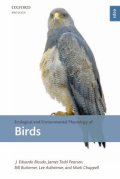
|
|
Shorebird Ecology, Conservation, and ManagementMark A. Colwell
University of California Press
2010
"Shorebirds are model organisms for illustrating the principles of ecology and excellent subjects for research. Their mating systems are as diverse as any avian group, their migrations push the limits of endurance, and their foraging is easily studied in the open habitats of estuaries and freshwater wetlands. This comprehensive text explores the ecology, conservation, and management of these fascinating birds. Beginning chapters examine phylogenetic relationships between shorebirds and other birds, and cover shorebird morphology, anatomy, and physiology. A section on breeding biology looks in detail at their reproductive biology. Because shorebirds spend much of their time away from breeding areas, a substantial section on non-breeding biology covers migration, foraging ecology, and social behavior. The text also covers shorebird demography, population size, and management issues related to habitat, predators, and human disturbances. Throughout, it emphasizes applying scientific knowledge to the conservation of shorebird populations, many of which are unfortunately in decline."
|
Buy from amazon.co.uk 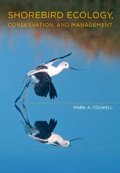
|
|
Current Ornithology, Volume 17Editor: Charles Thompson
Springer
2010
Contents:
- Impaired predator evasion in the life-history of birds: behavioural and physiological adaptations to reduced flight ability - J. Lind, S. Jakobsson and C. Kullberg
- Dietary Calcium Availability and Reproduction in Birds - S. J. Reynolds and C. Perrins
- Seasonal Metabolic Variation in Birds: Functional and Mechanistic Correlates- D.L. Swanson
- Assessing Cause-Effect Relationships in Environmental Accidents: Harlequin Ducks and the Exxon Valdez Oil Spill- J. A. Wiens, R. H. Day, S. M. Murphy, and M. A. Fraker
|
Buy from amazon.co.uk 
|
|
Salt Glands in Birds and ReptilesM. Peaker & J. L. Linzell
Monographs of the Physiological Society
Cambridge University Press
2009
"The aim of the authors in writing this monograph has been to provide a comprehensive and critical, but personal account of salt glands. Papers on salt glands are scattered through a great many different journals. There is therefore a great need for a synthesis of what is known about salt glands. The means by which salt glands perform their vital function of forming and excreting a concentrated salt solution is of great biological importance in understanding salt and water relations in the cells of all living things. In addition to the basic physiology of salt glands there is consideration of their ecological importance, their interaction with other systems of the body, their role in non-marine birds and reptiles and their evolution. Salt glands have interested biologists from a wide range of disciplines. This book brings together the scattered literature and will be a convenient source of reference to those working in the field, as well as providing information for comparative studies and for teaching purposes."
|
Buy from amazon.co.uk 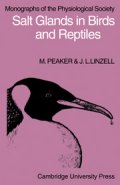
|
|
Ecology and Behavior of Chickadees and Titmice: An Integrated Approach
Ken A. Otter
Oxford University Press
2007
"Chickadees and titmice are among the most popular birds in North America, due in large part to their readiness to use bird feeders, to nest in urban gardens, and even to be trained to take food from people's hands. These attributes have also made them (and their Eurasian tit counterparts) perhaps the most intensively studied bird family in the world. Long-term research in Europe has yielded some of the most comprehensive data on the impact of global warming on the breeding ecology of birds. Chickadees have amongst the best-studied and most complex vocal behaviour of any bird species, displaying one of the closest analogies to human sentence structure in the animal kingdom in their familiar chick-a-dee call. The social dominance hierarchies commonly witnessed in the form of squabbling at winter feeders are some of most stable and closely studied, and have huge impacts on controlling the lives of these small birds. Their food-storing behavior, and the brain and physiological mechanisms controlling this, has contributed significantly to our wider understanding of spatial orientation. In recent years, these birds have also been used as model species for investigating topics as diverse as inter-species hybridization, the impacts of forest fragmentation and complex systems of communication. In short, chickadees and titmice have contributed enormously to our understanding of a myriad of topics in ecology, behavior and psychology. This book brings together a range of experts from across North America who utilise chickadees or titmice as study organisms. Each chapter reviews the latest advances in evolution and behavioral research that have been accomplished through the study of North American Parids, and compares and contrasts this literature with research on their Eurasian counterparts as well as other avian families. This research level text is aimed at professional avian biologists and ornithologists as well as graduate students of avian behavioral ecology and evolution. It will also appeal to a more general audience of behavioural ecologists, neuroethologists and experimental psychologists."
|
Buy from amazon.co.uk 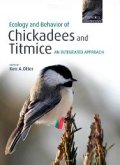
|
|
Raptor Research and Management TechniquesEditor: David M. Bird and Keith L. Bildstein
Hancock House Publishers
2007
"This is the much anticipated and thoroughly updated version of the popular but long out of print "Raptor Management Techniques Manual". Produced by the Raptor Research Foundation, this is a comprehensive work designed for use by raptor researchers and conservationists and natural-resource managers around the world. Each chapter has been authored by experts in the field and has undergone rigorous review. Not an all-inclusive manual or detailed 'how-to' book, this new work reflects the state of the art in raptor research, with up-to-date information on various techniques, and numerous references to additional sources for details and cautions regarding various field and laboratory techniques and management tools. Beginning with a general review of the field of raptor research, it includes insights into field-study techniques, information on the energetics, physiology, pathology, and toxicology of raptors; it covers reduction of management and researcher disturbance, mitigation, population monitoring at migration watchsites, captive breeding, the augmentation of wild populations, and rehabilitation, and concludes with chapters on public education and legal considerations. This book will enhance standardisation in the field, speed improvement in techniques and help those who study and manage birds to better protect them."
|
Buy from amazon.co.uk 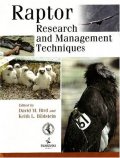
|
|
The Lung-Air Sac System of Birds: Development, Structure, and FunctionJohn N. Maina
Springer-Verlag
2006
"In biology, few organs have been as elusive as the lung-air sac system of birds. Considerable progress has recently been made to fill the gaps in the knowledge. While summarizing and building on earlier observations and ideas, this book provides cutting-edge details on the development, structure, function, and the evolutionary design of the avian respiratory system. Outlining the mechanisms and principles through which biological complexity and functional novelty have been crafted in a unique gas exchanger, this account will provoke further inquiries on the many still uncertain issues. The specific goal here was to highlight the uniqueness of the design of the avian respiratory system and the factors that obligated it."
|
Buy from amazon.co.uk 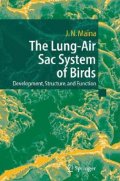
|
|
Bird Hormones and Bird Migrations: Analyzing Hormones in Droppings and Egg Yolks and Assessing Adaptations in Long-Distance MigrationWolfgang Goymann, Susanne Jenni-Eirmann, and Ulf Bauchinger
New York Academy of Sciences
2005
"The analysis of hormones in faeces or excrement presented in the first part of this volume is a relatively new non-invasive method for gaining insight into an animal's physiology. Endocrinological cycles of free-living animals can be studied without the stress caused by capture. Hence, this non-invasive technique may be helpful in a wide range of research fields relating to physiology, behavioural ecology, ethnology, and wildlife conservation. The reports presented in the second part of the volume expand the general understanding of migration over long distances. Three key issues in the search for adaptive syndromes are addressed: acquisition and use of endogenous resources, circadian rhythms, and adaptations in metabolism. The papers included in this volume will provide access to techniques and methods that will result in more reliable studies and more useful data."
|
Buy from amazon.co.uk 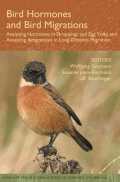
|
|
Avian FlightJohn J. Videler
Oxford University Press
2005
"This book provides an up-to-date account of our existing knowledge on the subject, offering new insights and challenging some established views. A brief history of the science of flight introduces the basic physical principles governing aerial locomotion. This is followed by a treatment of flight-related functional morphology, concentrating on the difference in shape of the arm and hand part of the wings, on the structure and function of tails, and on the shape of the body. The anatomy and mechanical properties of feathers receive special attention. Aerodynamic principles used by birds are explained in theory by simply applying Newton's laws, and in practice by showing the direction and velocity of the attached flow around an arm wing cross section and of the leading edge vortex flow above a hand wing. The Archaeopteryx fossils remain crucial in our understanding of the evolution of bird flight despite the recent discovery of a range of well-preserved ancient birds. Avian Flight offers a novel insight into the interactions between wings and air, which challenges established theories relating to the origin of bird flight." Contents: Preface; Acquisition of knowledge; The flight apparatus; Feathers for flight; Aerodynamics; Evolution of bird flight; Bird flight modes; The bird flight engine; Energy required for flight; Comparing the metabolic costs of flight."
|
Buy from amazon.co.uk 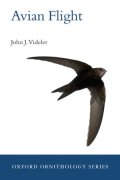
|
|
Environmental Physiology of AnimalsPat Wilmer, Graham Stone and Ian Johnson
Wiley-Blackwell
2nd edition
2004
"The new and updated edition of this accessible text provides a comprehensive overview of the comparative physiology of animals within an environmental context. Includes two brand new chapters on Nerves and Muscles and the Endocrine System. Discusses both comparative systems physiology and environmental physiology. Analyses and integrates problems and adaptations for each kind of environment: marine, seashore and estuary, freshwater, terrestrial and parasitic. Examines mechanisms and responses beyond physiology. Applies an evolutionary perspective to the analysis of environmental adaptation. Provides modern molecular biology insights into the mechanistic basis of adaptation, and takes the level of analysis beyond the cell to the membrane, enzyme and gene. Incorporates more varied material from a wide range of animal types, with less of a focus purely on terrestrial reptiles, birds and mammals and rather more about the spectacularly successful strategies of invertebrates.
|
Buy from amazon.co.uk 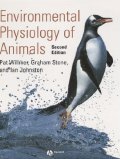
|
|
Animal PhysiologyRichard W. Hill, Gordon A. Wyse, Margaret Anderson
Sinauer Associates
2nd edition
2004
"Animal Physiology presents all the branches of modern animal physiology with a strong emphasis on integration among physiological disciplines, ecology, and evolutionary biology. The book takes an entirely fresh approach to each topic. Its full colour illustration program includes many novel, visually effective features to help students learn. Each of the 28 chapters starts with a brief animal example to engage student interest and demonstrate the value of the material that will be learned. The book includes five entire chapters that apply students' newfound physiological knowledge to curiosity provoking and important topics, including diving by marine mammals, the mechanisms of navigation, and training/disuse effects in muscle. The book is committed to a comparative approach throughout. While mammalian physiology is consistently treated in depth, emphasis is also given to the other vertebrate groups, arthropods, molluscs, and as appropriate additional invertebrates. Concepts and integrative themes are emphasized while giving students the specifics they need. The whole animal is the principal focus of this book.
|
Buy from amazon.co.uk 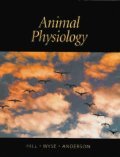
|
|
Avian Incubation: Behaviour, Environment and EvolutionEditor: D.C. Deeming
Oxford University Press
2002
"This is the first scientific review of all factors affecting incubation in avian nests. These range from nest construction, egg characteristics and patterns of embryonic development. There is an extensive section describing incubation behaviour of parents and embryos, and there are chapters reviewing brood patch physiology and the various factors determining the incubation environment, including nest microbiology. Another section provides chapters giving detailed descriptions of examples of unusual aspects of avian incubation, whilst the final section provides consideration of the ecological, energetic and fitness cost of incubation. Written by authorities in their respective fields from around the world, this provides a comprehensive review of this critical aspect of avian reproduction. Much of the data included has not been previously published, and so Avian Incubation is not only an extensive reference text but is also a valuable contribution to our basic understanding of incubation." Contents: D C Deeming: Importance and Evolution of Incubation in Avian reproduction; M H Hansell and D C Deeming: Location Structure and Function of Incubation Sites; D C Deeming: Functional Characteristics of Eggs; D C Deeming: Embryonic Development and Utilisation of Egg Components; C M Vleck: Hormonal Control of Incubation Behaviour; D C Deeming: Behaviour Patterns During Incubation; R B Brua: Parent-Embryo Interactions; R W Lea abd H Klandorf: The Brood Patch; J S Turner: Maintenance of Egg Temperature; A Ar and Y Sidis: Nest Microclimate During Incubation; D C Deeming: Patterns and Significance of Egg Turning; G K Baggott and K Graeme-Cook: Microbiology of Natural Incubation; D T Booth and D N Jones: Underground Nesting in the Megapodes; W A Calder III: Characteristics and Constraints of Incubation in Hummingbirds; F R Handsworth and M A Voss: Intermittent Incubation: Predictions and Tests for Time and Heat Allocations; C Carey: Incubation in Extreme Environments; S G Sealy, D G McMaster and B D Peer: Tactics of Obligate Brood Parasites to Secure Suitable Incubators; P N Hebert: Ecological Factors Affecting Initiation of Incubation Behaviour; T J Underwood and S G Sealy: Adaptive Significance of Egg Colouration; J M Tinbergen and J B Williams: Energetics of Incubation; J Reid, P Monaghan and R Nager: Incubation and the Costs of Reproduction; D C Deeming: Perspectives in Avian Incubation.
|
Buy from amazon.co.uk 
|
|
Avian MigrationEditors: P Berthold, E Gwinner and E Sonnenschein
Springer-Verlag
2002
"The reader of this comprehensive presentation benefits from an outstanding overview of all aspects of the fascinating phenomenon of bird migration. The book is written by leading experts from around the world. The text summarises reviews and discussions of the most recent hypotheses. In doing so, it covers the entire research field from phenomenology through to ecology, physiology, control mechanisms, orientation, evolutionary aspects and conservation measures. It also examines the most modern methodological approaches including, satellite tracking, molecular techniques or stable isotope investigations and envisages forthcoming developments in the course of global warming."
|
Buy from amazon.co.uk 
|
|
The Evolution of Begging: Competition, Cooperation and CommunicationJonathan Wright and Marty L. Leonard
Kluwer Academic Publishers
2002
"Begging by nestling birds has become the model system for investigating evolutionary conflicts of interest within families and their theoretical resolution provided by honest signals of offspring need. In response to the recent explosions of scientific papers on the revolution of begging; we have brought together twenty-four original contributions from major researchers in all areas of this dynamic field. Organised into six sections: I: Theoretical approaches; II: Begging as a signal; III: Nestling physiology; IV: Sibling competition; V: Brood parasitism; and VI: Statistical approaches; this book is primarily aimed at research scientists and those at the graduate student level. For the first time, the theoretical and empirical literature on begging is fully reviewed. New ideas and data are also presented from a wide range of natural systems, and each chapter ends with suggestions for future study."
|
Buy from amazon.co.uk 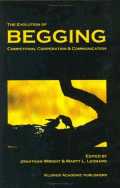
|
|
Biology of Marine BirdsEditors: Elizabeth A. Schreiber & Joanna Burger
CRC Press Inc
2001
This book reviews information about marine birds ranging from general breeding biology, ecology, evolution, and fossil history to energetics, physiology, and conservation. The taxa covered comprise the four orders of primary seabirds: Sphenisciformes (penguins), Procellariiformes (albatrosses, shearwaters, petrels), Pelecaniformes (pelicans, boobies, frigatebirds, tropicbirds, cormorants), and certain Charadriiformes (alcids, gulls, and terns). Some marine-associated shorebirds and wading birds are also included.
|
Buy from amazon.co.uk 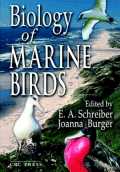
|
|
Current Ornithology, Volume 16Editor: Val Nolan and Charles Thompson
Springer
2001
Contents:
- Avian colonialty: progress and problems - Charles R. Brown and Mary Bomberger Brown
- Begging in nestling birds - Amber E. Budden and Jonathan Wright
- Ecological aspects of neophobia and neophilia in birds - Russell Greenberg and Claudia Mettke-Hofmann
- Avian quantitative genetics - Juha Merila and Ben C. Sheldon
- Male parental care and paternity - Linda A. Whittingham and Peter O. Dunn
- Physiological ecology and behavoir of desert birds - Joseph B. Williams
- Reproductive energy expenditure, intraspecfic variation and fitness in birds - Tony D. Williams and Francois Vezina
|
Buy from amazon.co.uk 
|
|
Bird Migration: A General SurveyPeter Berthold
Oxford University Press
2001 (2nd edition)
"Ten years have passed since the first edition of this book. During that time the field of bird migration has experienced many advances which are reflected in this second edition. No other book exists to bring together the vast amount of information currently available on the subject of bird migration. Includes discussion of evolution and history of bird migration, physiology, orientation mechanisms and threats to migrations and is accessible to experts as well as amateurs." Contents: Introduction; Evolution, genetic basis, and extent of bird migration; History of bird migration studies; Current methods of studying bird migration; The phenomena of bird migration; Physiological bases and control of bird migration; Orientation mechanisms; Synopsis: course and control of migration of a typical long-distance migrant passerine; Threats and the conservation and future of migrants; Evolutionary aspects of bird migration in the future; The significance of bird migration for human society; Outlook.
|
Buy from amazon.co.uk 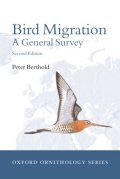
|
|
Sturkie's Avian PhysiologyEditor: G. Causey Whittow
Academic Press
5th edition
1999
"Sturkie's Avian Physiology is the classic comprehensive single volume on the physiology of domestic as well as wild birds. The Fifth Edition is thoroughly revised and updated, and includes new chapters on the physiology of incubation and growth. Chapters on the nervous system and sensory organs have been greatly expanded due to the many recent advances in the field. The text also covers the physiology of flight, reproduction in both male and female birds, and the immunophysiology of birds. The Fifth Edition, like the earlier editions, is a must for anyone interested in comparative physiology, poultry science, veterinary medicine, and related fields. This volume establishes the standard for those who need the latest and best information on the physiology of birds."
|
Buy from amazon.co.uk 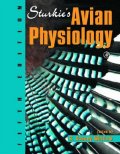
|
|
Manual of Ornithology: Avian Structure and FunctionNoble S. Proctor and Patrick J. Lynch
Yale University Press
1998
"This book - a visual guide to the structure and anatomy of birds - is one of the most heavily illustrated ornithology references ever written. A concise atlas of anatomy, it contains more than 200 specially prepared accurate and clear drawings that include material never illustrated before. The text is as informative as the drawings; written at a level appropriate to undergraduate students and to bird lovers in general, it discusses why birds look and act the way they do. Designed to supplement a basic ornithology textbook, the "Manual of Ornithology" covers systematics and evolution, topography, feathers and flight, the skeleton and musculature, and the digestive, circulatory, respiratory, excretory, reproductive, sensory and nervous systems of birds, as well as field techniques for watching and studying birds. Each chapter concludes with a list of key references for the topic covered, with a comprehensive bibliography at the end of the volume."
|
Buy from amazon.co.uk 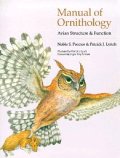
|
|
Current Ornithology, Volume 14Editor: Val Nolan, Ellen D. Ketterson and Charles F. Thompson
Plenum
1997
Contents:
- Physiological, ecological, and evolutionary bases for the avoidance of chemical irritants by birds - L. Clark
- Temporal flexibility in avian reproduction: patterns and mechanisms - T.P. Hahn, T. Boswell, J.C. Wingfield and G.F. Ball
- Sexual selection and the evolution of song repertoires S.A. MacDougall-Shackleton
- Social dominance in birds: early findings and new horizons - W.H. Piper
- Energy management in passerine birds during the nonbreeding season: a review - V.V. Pravosudov and T.C. Grubb
- Motor correlates of vocal diversity in songbirds - R.A. Suthers and F. Goller
|
Buy from amazon.co.uk 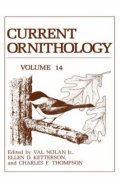
|
|
The Behaviour, Population Biology and Physiology of the PetrelsJohn Warham
Academic Press Inc
1996
The second volume of two volume study of Petrels. This volume covers the behaviour and biology of the Petrels and includes chapters on distribution, dispersal and migration, feeding and foods, behavior and vocalizations, physiology and energetics, biochemistry, locomotion, anatomy, evolution and radiation, and Petrels and man.
|
Buy from amazon.co.uk 
|
|
Ecophysiology of Desert BirdsGordon Lindsay Maclean
Adaptations of Desert Organisms Series
Springer
1995
"The scientific study of birds in arid regions has been conducted more or less intensively for about 40 years. This is an appropriate time to draw together the threads of the diverse research on birds living in such an extreme environment. Topics include: Desert Avifaunas; Food and Energy; Drinking; Water Regulation; Thermoregulation; Timing of Breeding; and Ecology of Breeding."
|
Buy from amazon.co.uk 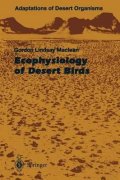
|
|
Bird Migration: Physiology and EcophysiologyEditor: E. Gwinner
Springer-Verlag
1991
"This multi-author volume reviews the present state of knowledge about the physiology and ecophysiology of migratory birds. Main aspects are patterns of migration, ecological and behavioural aspects of migration, physiological adaptations to migration, bird flight, and strategies and tactics of migration. Based on papers presented during a symposium, Bird Migration offers both students and senior scientists a comprehensive survey."
|
Buy from amazon.co.uk 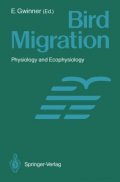
|
|
Physiology of Cold Adaptation in BirdsEditor: Claus Bech and Randi Eidsmo Reinertsen
Springer-Verlag
1988
"Thirty-nine contributions treat the central mechanisms of thermoregulation, heat production, metabolic adaptations, respiration and circulation, physiology of hypometabolism, breeding and incubation, and adaptations to cold in chicks."
|
Buy from amazon.co.uk 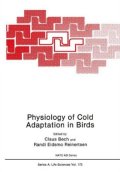
|
|
An Analysis of Physical, Physiological and Optical Aspects of Avian Coloration with Emphasis on Wood-WarblersEdward H Burtt
Ornithological Monographs 38
American Ornithologists' Union
1986
From Chapter 1: Statement Of The problem: "Color is a characteristic of multicellular organisms, each of which has one or more colors distributed in a pattern that may be a single uniform color or a multicolored patchwork. Many evolutionary functions have been suggested for the effect of color on optical signalling (Thayer 1909; Cott 1957; Hailman 1977a; Rohwer et al. 1980; Rohwer 1982). More recently nonoptical functions of color have received limited attention (Burtt 1979, 1984; Underwood 1979; Walsberg 1982, 1983) and an integrated approach to the evolutionary significance of color has begun to emerge (Burtt 1979, 1981). By exploring a variety of evolutionary hypotheses relating color and color patterns of wood-warblers (Emberizidae: Parulinae) to the physical environment, this monograph further emphasizes the important insights that follow from an integrated approach to the evolutionary significance of color."
|
Buy from amazon.co.uk 
|
|
Avian PhysiologyEditor: P.D. Sturkie
Springer
4th edition
1986
Preface: "Since the publication of earlier editions, there has been a considerable increase in research activity ina number of areas, with each succeeding edition including new chapters and an expansion of knowledge in older chapters. The fourth edition contains two new chapters, on muscle and immunophysiology, the latter an area where research on Aves has contributed significantly to our general knowledge of the subject. The new edition has a number of new contributors, who have written on the nervous system, sense organs, muscle, endocrines, reproduction, digestion and immunophysiology. Contributors from previous editions have expanded their offerings considerably. The authors are indebted to various investigators, journals and books for the many illustrations used. Individual acknowledgement is made in the legends and references."
|
Buy from amazon.co.uk 
|
|
Tropical Seabird BiologyEditor: Ralph W. Schreiber
Studies in Avian Biology No 8
Cooper Ornithological Society
1984
Contents;
- Introduction - Ralph W. Schreiber
- An ecological comparison of oceanic seabird communities of the south pacific ocean - David G. Ainley And Robert J. Boekelheide
- Feeding overlap in some tropical and temperate seabird communities - A. W. Diamond
- Physiological ecology of incubation in tropical seabirds - G. C. Whittow
- Growth strategies in marine terns - N. P. Langham
- Some considerations of the reproductive energetics of pelagic seabirds - Robert E. Ricklefs
- Contrasts in breeding strategies between some tropical and temperate marine pelecaniformes - J. B. Nelson
|
Buy from amazon.co.uk 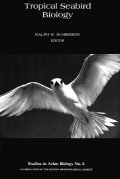
|
|
Physiology and Behaviour of the PigeonMichael Abs
Academic Press Inc
1983
|
Buy from amazon.co.uk 
|
|
Avian PhysiologyP.D. Sturkie
Springer
3rd edition
1976
|
Buy from amazon.co.uk 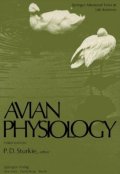
|
|
Bird Song: Acoustics and PhysiologyCrawford H. Greenewalt
Smithsonian
1968
|
Buy from amazon.co.uk 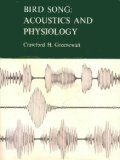
|
|